BAO6714 Report: SAP S/4HANA Finance, Case Studies, and Analysis
VerifiedAdded on 2022/10/06
|18
|4901
|292
Report
AI Summary
This report provides a comprehensive analysis of SAP S/4HANA Finance, examining its historical evolution, key features, and advantages over traditional ERP and FICO systems. It delves into the benefits for businesses, including improved reporting, real-time analytics, and streamlined processes. The report also presents case studies of companies that have implemented SAP S/4HANA Finance, highlighting the challenges and successes of migration. Furthermore, the report compares SAP S/4HANA with SAP ERP and SAP FICO, focusing on their functional differences. It also discusses the importance of SAP S/4HANA in the digital age and its role in helping businesses leverage big data for informed decision-making and improved performance. The report emphasizes the importance of SAP S/4HANA in the digital age, highlighting its role in helping businesses leverage big data for informed decision-making and improved performance.
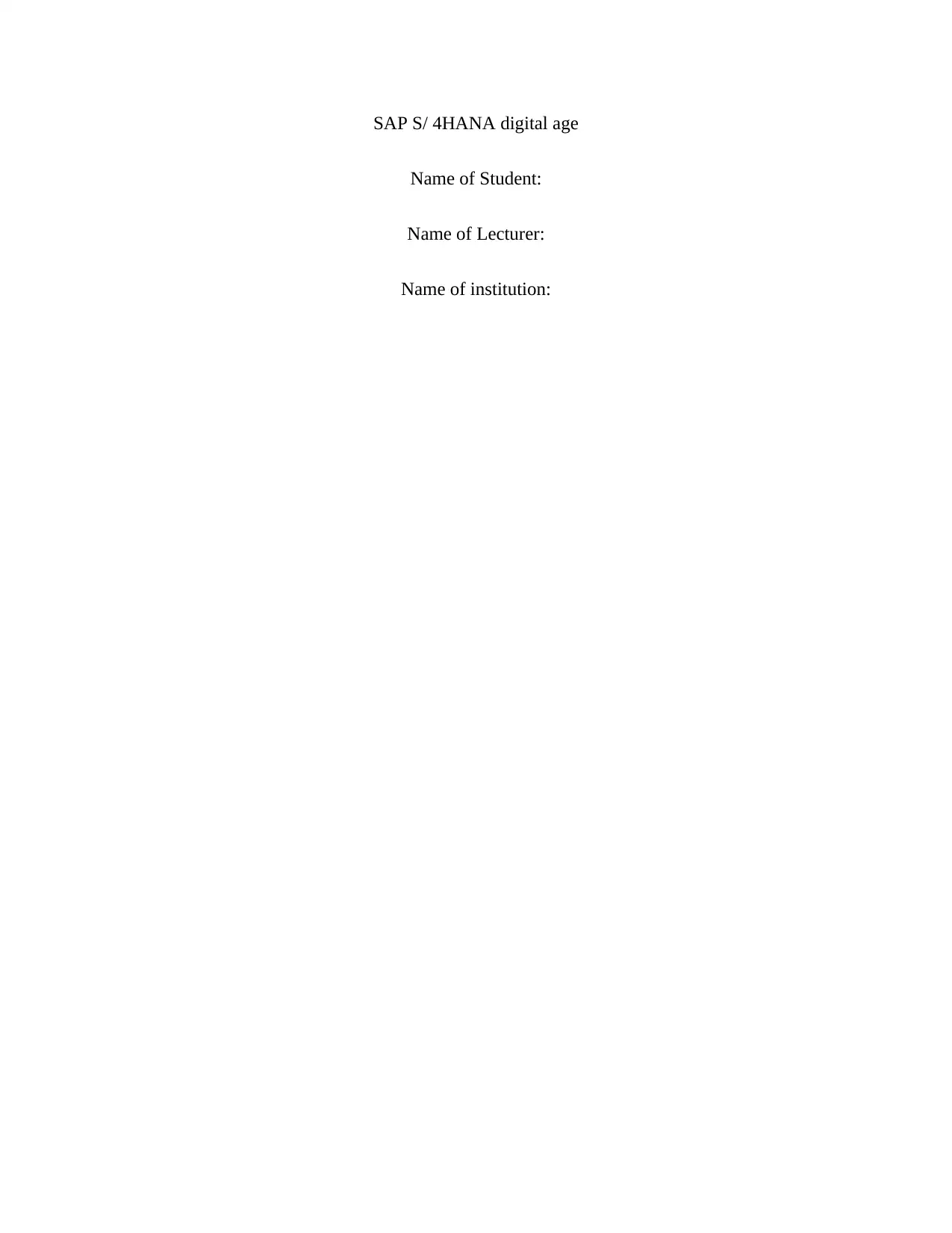
SAP S/ 4HANA digital age
Name of Student:
Name of Lecturer:
Name of institution:
Name of Student:
Name of Lecturer:
Name of institution:
Paraphrase This Document
Need a fresh take? Get an instant paraphrase of this document with our AI Paraphraser

Introduction
The way things are handled in business world have drastically changed due to stiff competition
across all business industries. The changes are sought for to improve the efficiency of business
activities from production to provision of services. Business leaders are struggling to adopt new
ways of running the business including automating most of the business activities to save time
(Scranton and Fredison, 2013). All these changes from automation of business process to
improving the efficiency of service delivery have been enhanced due to high levels of technology
development in the world. Technologists have for long been working tirelessly to ensure that
human errors are eradicated from the business transactions for the benefits of both the sellers and
the buyers. Data management system is very important for any healthy and existing business
since business organizations can easily trace the root cause of particular problems and bring solid
solution to the problems (Shang et al, 2014). Considering the situations of businesses in the
market, software developing companies developed and introduced to the market enterprise
resource planning software (ERP) that is responsible in handling financial transactions,
procurement and other business activities (Monk and Wagner, 2012). Various software such as
SAP SRM, SAP CRM and SAP ERP are also other examples of the software that help in
business operations to culminate the pressure of handling data and making informed decisions
that steer ahead the businesses (Sulit and Buenviaje, 2016). Developing the earlier listed
software had never brought the software developing companies to a rest for they further kept on
trying to bring the best product that is most efficient in its operation and due to their continuous
hard work, they ended up with SAP business Suite 4 that they made to only run in SAP HANA
database with all other features combined as a single product. Companies have been jostling to
The way things are handled in business world have drastically changed due to stiff competition
across all business industries. The changes are sought for to improve the efficiency of business
activities from production to provision of services. Business leaders are struggling to adopt new
ways of running the business including automating most of the business activities to save time
(Scranton and Fredison, 2013). All these changes from automation of business process to
improving the efficiency of service delivery have been enhanced due to high levels of technology
development in the world. Technologists have for long been working tirelessly to ensure that
human errors are eradicated from the business transactions for the benefits of both the sellers and
the buyers. Data management system is very important for any healthy and existing business
since business organizations can easily trace the root cause of particular problems and bring solid
solution to the problems (Shang et al, 2014). Considering the situations of businesses in the
market, software developing companies developed and introduced to the market enterprise
resource planning software (ERP) that is responsible in handling financial transactions,
procurement and other business activities (Monk and Wagner, 2012). Various software such as
SAP SRM, SAP CRM and SAP ERP are also other examples of the software that help in
business operations to culminate the pressure of handling data and making informed decisions
that steer ahead the businesses (Sulit and Buenviaje, 2016). Developing the earlier listed
software had never brought the software developing companies to a rest for they further kept on
trying to bring the best product that is most efficient in its operation and due to their continuous
hard work, they ended up with SAP business Suite 4 that they made to only run in SAP HANA
database with all other features combined as a single product. Companies have been jostling to
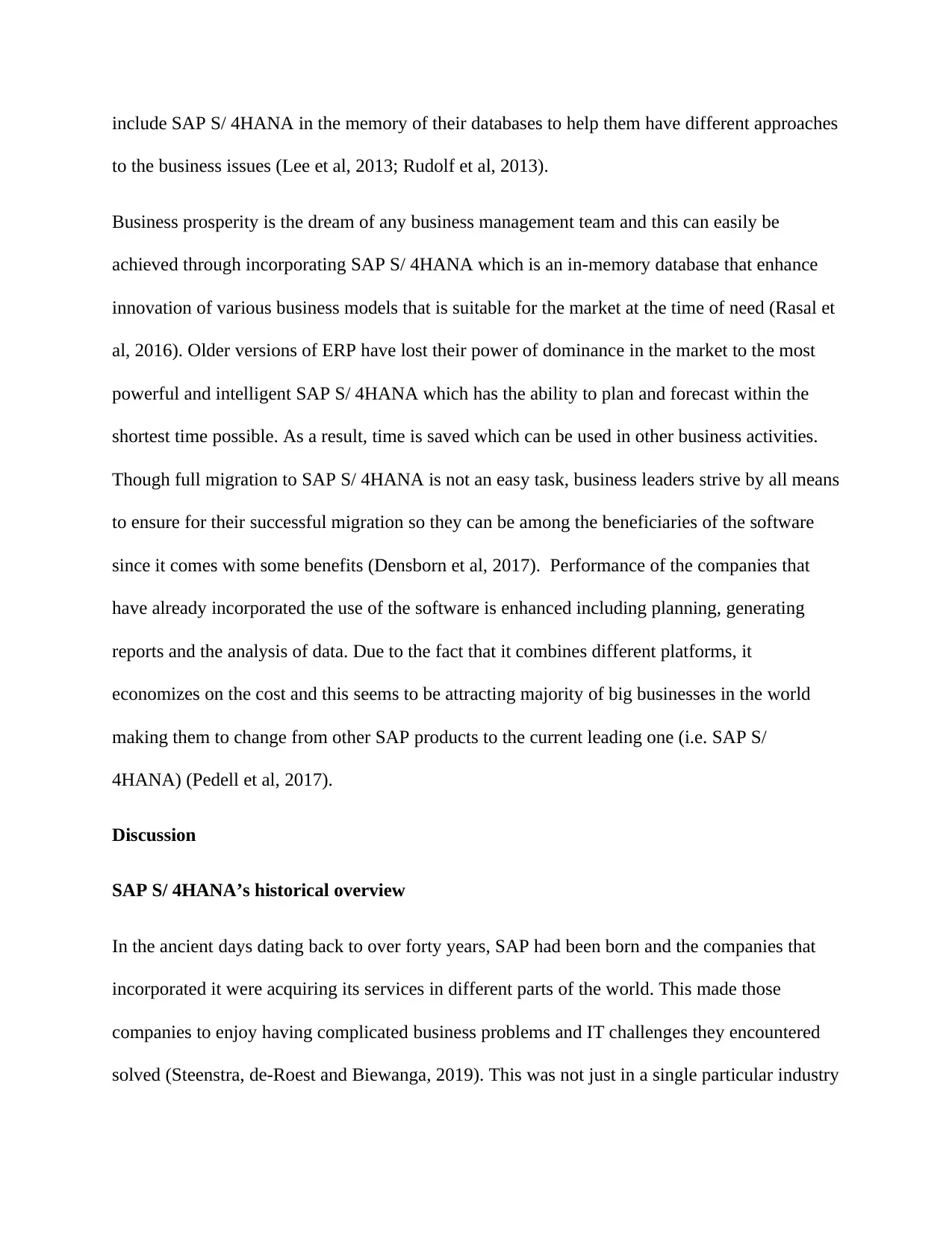
include SAP S/ 4HANA in the memory of their databases to help them have different approaches
to the business issues (Lee et al, 2013; Rudolf et al, 2013).
Business prosperity is the dream of any business management team and this can easily be
achieved through incorporating SAP S/ 4HANA which is an in-memory database that enhance
innovation of various business models that is suitable for the market at the time of need (Rasal et
al, 2016). Older versions of ERP have lost their power of dominance in the market to the most
powerful and intelligent SAP S/ 4HANA which has the ability to plan and forecast within the
shortest time possible. As a result, time is saved which can be used in other business activities.
Though full migration to SAP S/ 4HANA is not an easy task, business leaders strive by all means
to ensure for their successful migration so they can be among the beneficiaries of the software
since it comes with some benefits (Densborn et al, 2017). Performance of the companies that
have already incorporated the use of the software is enhanced including planning, generating
reports and the analysis of data. Due to the fact that it combines different platforms, it
economizes on the cost and this seems to be attracting majority of big businesses in the world
making them to change from other SAP products to the current leading one (i.e. SAP S/
4HANA) (Pedell et al, 2017).
Discussion
SAP S/ 4HANA’s historical overview
In the ancient days dating back to over forty years, SAP had been born and the companies that
incorporated it were acquiring its services in different parts of the world. This made those
companies to enjoy having complicated business problems and IT challenges they encountered
solved (Steenstra, de-Roest and Biewanga, 2019). This was not just in a single particular industry
to the business issues (Lee et al, 2013; Rudolf et al, 2013).
Business prosperity is the dream of any business management team and this can easily be
achieved through incorporating SAP S/ 4HANA which is an in-memory database that enhance
innovation of various business models that is suitable for the market at the time of need (Rasal et
al, 2016). Older versions of ERP have lost their power of dominance in the market to the most
powerful and intelligent SAP S/ 4HANA which has the ability to plan and forecast within the
shortest time possible. As a result, time is saved which can be used in other business activities.
Though full migration to SAP S/ 4HANA is not an easy task, business leaders strive by all means
to ensure for their successful migration so they can be among the beneficiaries of the software
since it comes with some benefits (Densborn et al, 2017). Performance of the companies that
have already incorporated the use of the software is enhanced including planning, generating
reports and the analysis of data. Due to the fact that it combines different platforms, it
economizes on the cost and this seems to be attracting majority of big businesses in the world
making them to change from other SAP products to the current leading one (i.e. SAP S/
4HANA) (Pedell et al, 2017).
Discussion
SAP S/ 4HANA’s historical overview
In the ancient days dating back to over forty years, SAP had been born and the companies that
incorporated it were acquiring its services in different parts of the world. This made those
companies to enjoy having complicated business problems and IT challenges they encountered
solved (Steenstra, de-Roest and Biewanga, 2019). This was not just in a single particular industry
⊘ This is a preview!⊘
Do you want full access?
Subscribe today to unlock all pages.

Trusted by 1+ million students worldwide
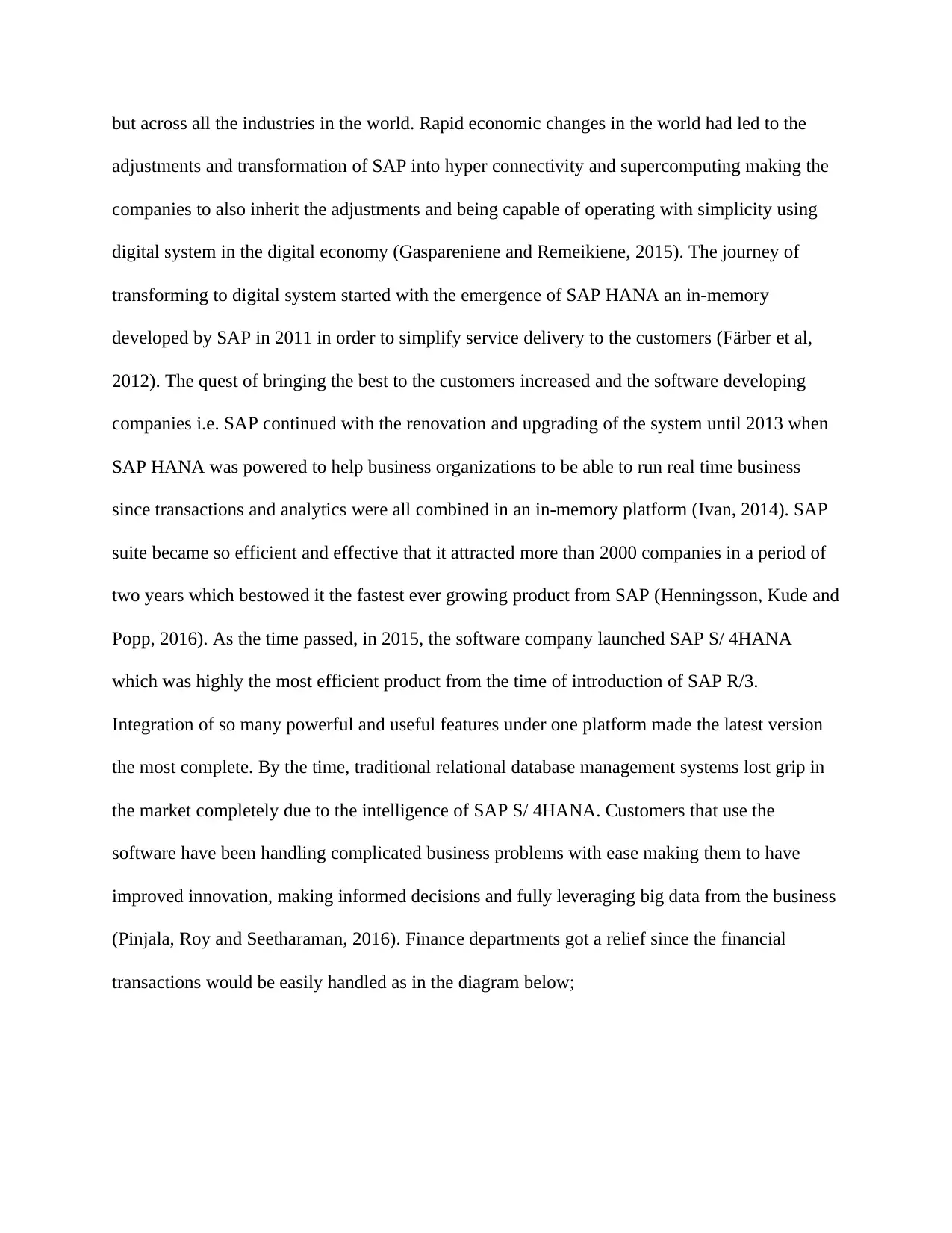
but across all the industries in the world. Rapid economic changes in the world had led to the
adjustments and transformation of SAP into hyper connectivity and supercomputing making the
companies to also inherit the adjustments and being capable of operating with simplicity using
digital system in the digital economy (Gaspareniene and Remeikiene, 2015). The journey of
transforming to digital system started with the emergence of SAP HANA an in-memory
developed by SAP in 2011 in order to simplify service delivery to the customers (Färber et al,
2012). The quest of bringing the best to the customers increased and the software developing
companies i.e. SAP continued with the renovation and upgrading of the system until 2013 when
SAP HANA was powered to help business organizations to be able to run real time business
since transactions and analytics were all combined in an in-memory platform (Ivan, 2014). SAP
suite became so efficient and effective that it attracted more than 2000 companies in a period of
two years which bestowed it the fastest ever growing product from SAP (Henningsson, Kude and
Popp, 2016). As the time passed, in 2015, the software company launched SAP S/ 4HANA
which was highly the most efficient product from the time of introduction of SAP R/3.
Integration of so many powerful and useful features under one platform made the latest version
the most complete. By the time, traditional relational database management systems lost grip in
the market completely due to the intelligence of SAP S/ 4HANA. Customers that use the
software have been handling complicated business problems with ease making them to have
improved innovation, making informed decisions and fully leveraging big data from the business
(Pinjala, Roy and Seetharaman, 2016). Finance departments got a relief since the financial
transactions would be easily handled as in the diagram below;
adjustments and transformation of SAP into hyper connectivity and supercomputing making the
companies to also inherit the adjustments and being capable of operating with simplicity using
digital system in the digital economy (Gaspareniene and Remeikiene, 2015). The journey of
transforming to digital system started with the emergence of SAP HANA an in-memory
developed by SAP in 2011 in order to simplify service delivery to the customers (Färber et al,
2012). The quest of bringing the best to the customers increased and the software developing
companies i.e. SAP continued with the renovation and upgrading of the system until 2013 when
SAP HANA was powered to help business organizations to be able to run real time business
since transactions and analytics were all combined in an in-memory platform (Ivan, 2014). SAP
suite became so efficient and effective that it attracted more than 2000 companies in a period of
two years which bestowed it the fastest ever growing product from SAP (Henningsson, Kude and
Popp, 2016). As the time passed, in 2015, the software company launched SAP S/ 4HANA
which was highly the most efficient product from the time of introduction of SAP R/3.
Integration of so many powerful and useful features under one platform made the latest version
the most complete. By the time, traditional relational database management systems lost grip in
the market completely due to the intelligence of SAP S/ 4HANA. Customers that use the
software have been handling complicated business problems with ease making them to have
improved innovation, making informed decisions and fully leveraging big data from the business
(Pinjala, Roy and Seetharaman, 2016). Finance departments got a relief since the financial
transactions would be easily handled as in the diagram below;
Paraphrase This Document
Need a fresh take? Get an instant paraphrase of this document with our AI Paraphraser
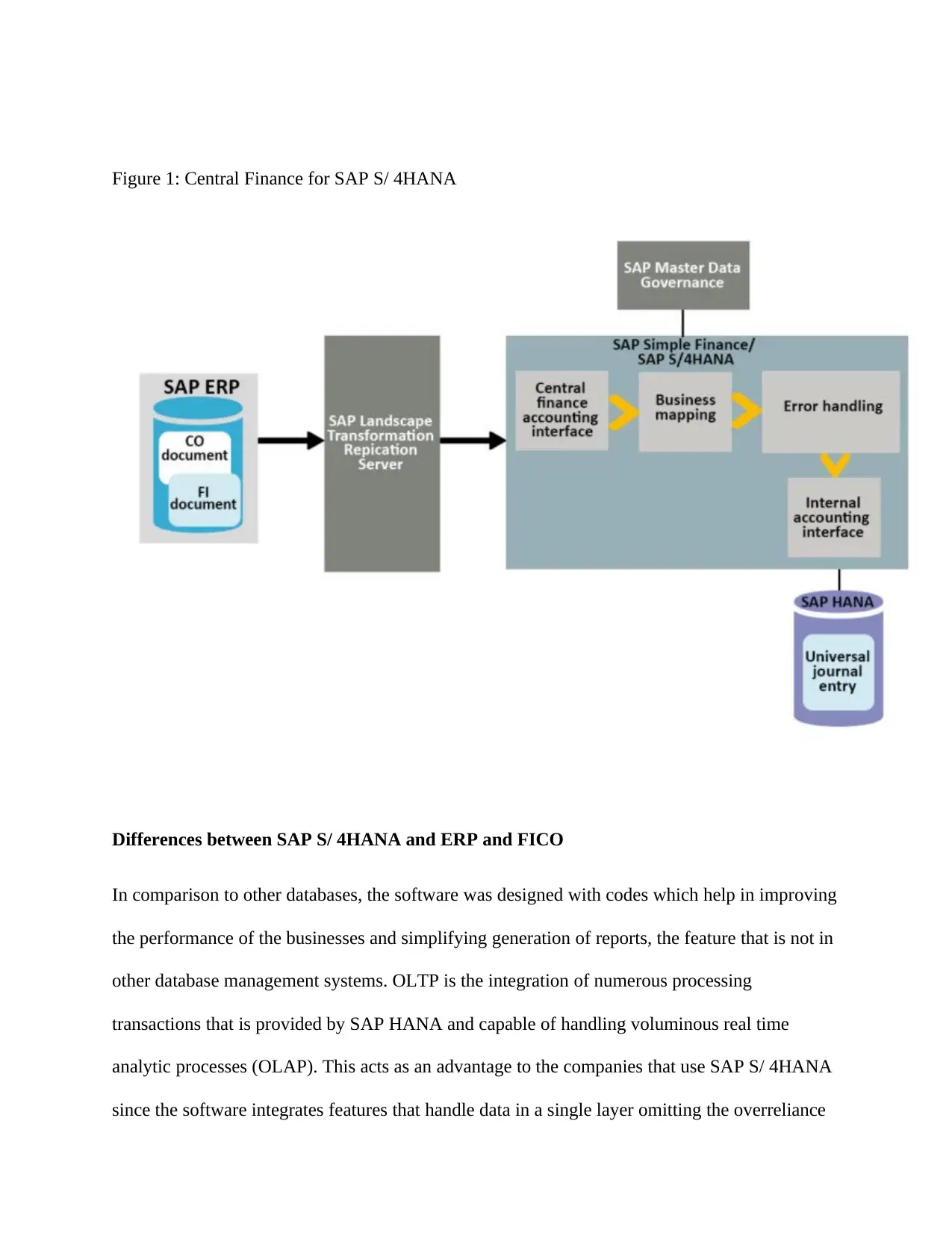
Figure 1: Central Finance for SAP S/ 4HANA
Differences between SAP S/ 4HANA and ERP and FICO
In comparison to other databases, the software was designed with codes which help in improving
the performance of the businesses and simplifying generation of reports, the feature that is not in
other database management systems. OLTP is the integration of numerous processing
transactions that is provided by SAP HANA and capable of handling voluminous real time
analytic processes (OLAP). This acts as an advantage to the companies that use SAP S/ 4HANA
since the software integrates features that handle data in a single layer omitting the overreliance
Differences between SAP S/ 4HANA and ERP and FICO
In comparison to other databases, the software was designed with codes which help in improving
the performance of the businesses and simplifying generation of reports, the feature that is not in
other database management systems. OLTP is the integration of numerous processing
transactions that is provided by SAP HANA and capable of handling voluminous real time
analytic processes (OLAP). This acts as an advantage to the companies that use SAP S/ 4HANA
since the software integrates features that handle data in a single layer omitting the overreliance
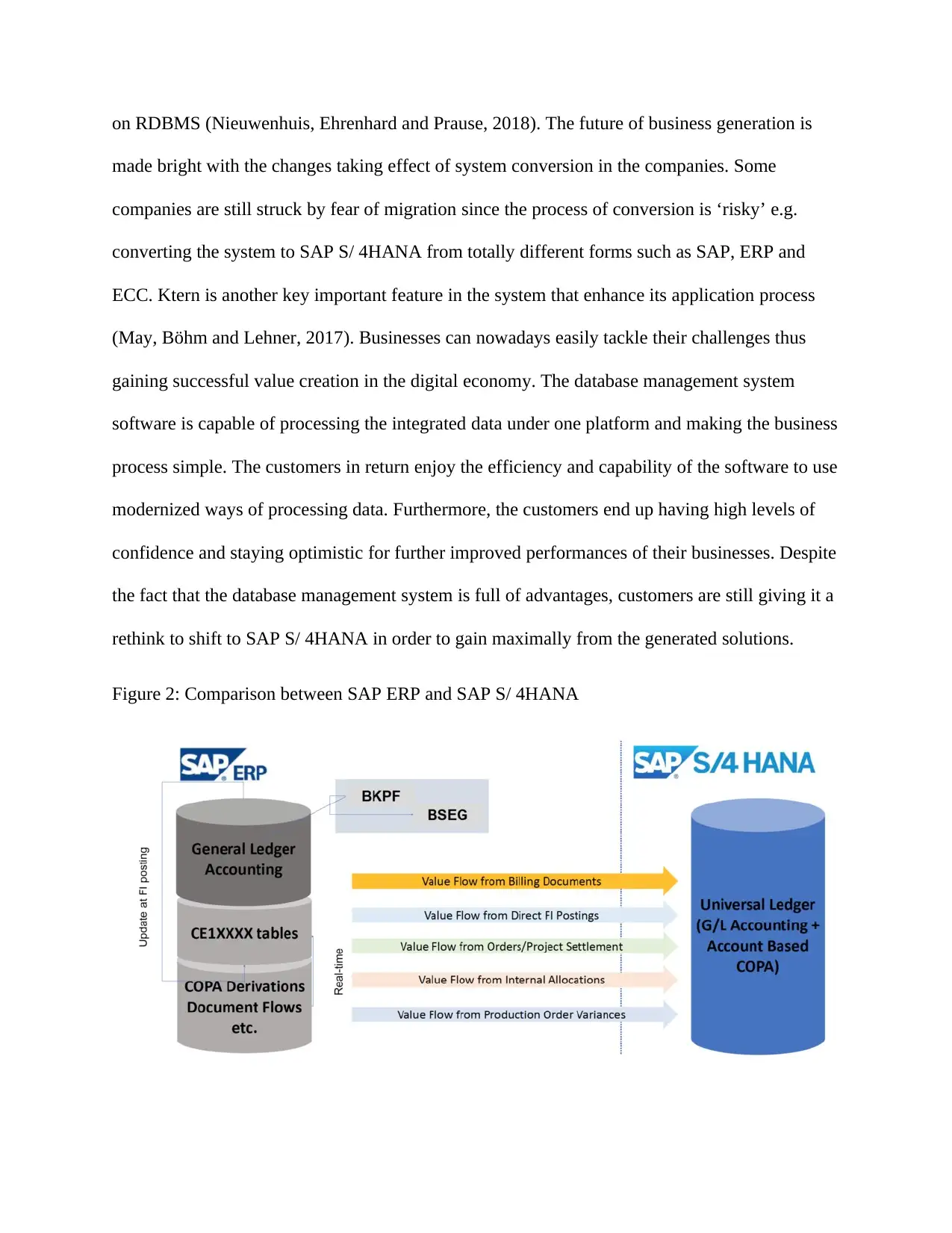
on RDBMS (Nieuwenhuis, Ehrenhard and Prause, 2018). The future of business generation is
made bright with the changes taking effect of system conversion in the companies. Some
companies are still struck by fear of migration since the process of conversion is ‘risky’ e.g.
converting the system to SAP S/ 4HANA from totally different forms such as SAP, ERP and
ECC. Ktern is another key important feature in the system that enhance its application process
(May, Böhm and Lehner, 2017 ). Businesses can nowadays easily tackle their challenges thus
gaining successful value creation in the digital economy. The database management system
software is capable of processing the integrated data under one platform and making the business
process simple. The customers in return enjoy the efficiency and capability of the software to use
modernized ways of processing data. Furthermore, the customers end up having high levels of
confidence and staying optimistic for further improved performances of their businesses. Despite
the fact that the database management system is full of advantages, customers are still giving it a
rethink to shift to SAP S/ 4HANA in order to gain maximally from the generated solutions.
Figure 2: Comparison between SAP ERP and SAP S/ 4HANA
made bright with the changes taking effect of system conversion in the companies. Some
companies are still struck by fear of migration since the process of conversion is ‘risky’ e.g.
converting the system to SAP S/ 4HANA from totally different forms such as SAP, ERP and
ECC. Ktern is another key important feature in the system that enhance its application process
(May, Böhm and Lehner, 2017 ). Businesses can nowadays easily tackle their challenges thus
gaining successful value creation in the digital economy. The database management system
software is capable of processing the integrated data under one platform and making the business
process simple. The customers in return enjoy the efficiency and capability of the software to use
modernized ways of processing data. Furthermore, the customers end up having high levels of
confidence and staying optimistic for further improved performances of their businesses. Despite
the fact that the database management system is full of advantages, customers are still giving it a
rethink to shift to SAP S/ 4HANA in order to gain maximally from the generated solutions.
Figure 2: Comparison between SAP ERP and SAP S/ 4HANA
⊘ This is a preview!⊘
Do you want full access?
Subscribe today to unlock all pages.

Trusted by 1+ million students worldwide
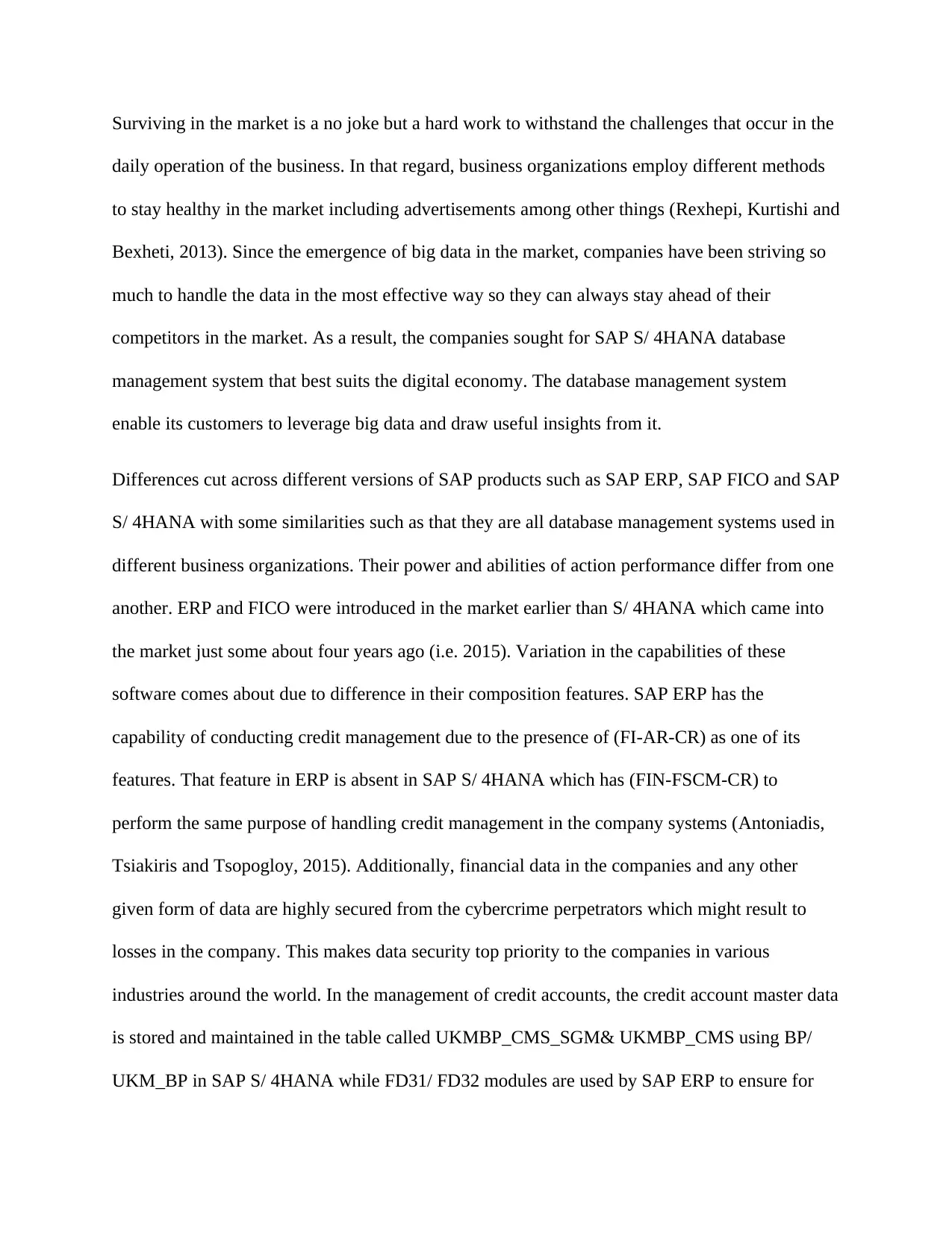
Surviving in the market is a no joke but a hard work to withstand the challenges that occur in the
daily operation of the business. In that regard, business organizations employ different methods
to stay healthy in the market including advertisements among other things (Rexhepi, Kurtishi and
Bexheti, 2013). Since the emergence of big data in the market, companies have been striving so
much to handle the data in the most effective way so they can always stay ahead of their
competitors in the market. As a result, the companies sought for SAP S/ 4HANA database
management system that best suits the digital economy. The database management system
enable its customers to leverage big data and draw useful insights from it.
Differences cut across different versions of SAP products such as SAP ERP, SAP FICO and SAP
S/ 4HANA with some similarities such as that they are all database management systems used in
different business organizations. Their power and abilities of action performance differ from one
another. ERP and FICO were introduced in the market earlier than S/ 4HANA which came into
the market just some about four years ago (i.e. 2015). Variation in the capabilities of these
software comes about due to difference in their composition features. SAP ERP has the
capability of conducting credit management due to the presence of (FI-AR-CR) as one of its
features. That feature in ERP is absent in SAP S/ 4HANA which has (FIN-FSCM-CR) to
perform the same purpose of handling credit management in the company systems (Antoniadis,
Tsiakiris and Tsopogloy, 2015). Additionally, financial data in the companies and any other
given form of data are highly secured from the cybercrime perpetrators which might result to
losses in the company. This makes data security top priority to the companies in various
industries around the world. In the management of credit accounts, the credit account master data
is stored and maintained in the table called UKMBP_CMS_SGM& UKMBP_CMS using BP/
UKM_BP in SAP S/ 4HANA while FD31/ FD32 modules are used by SAP ERP to ensure for
daily operation of the business. In that regard, business organizations employ different methods
to stay healthy in the market including advertisements among other things (Rexhepi, Kurtishi and
Bexheti, 2013). Since the emergence of big data in the market, companies have been striving so
much to handle the data in the most effective way so they can always stay ahead of their
competitors in the market. As a result, the companies sought for SAP S/ 4HANA database
management system that best suits the digital economy. The database management system
enable its customers to leverage big data and draw useful insights from it.
Differences cut across different versions of SAP products such as SAP ERP, SAP FICO and SAP
S/ 4HANA with some similarities such as that they are all database management systems used in
different business organizations. Their power and abilities of action performance differ from one
another. ERP and FICO were introduced in the market earlier than S/ 4HANA which came into
the market just some about four years ago (i.e. 2015). Variation in the capabilities of these
software comes about due to difference in their composition features. SAP ERP has the
capability of conducting credit management due to the presence of (FI-AR-CR) as one of its
features. That feature in ERP is absent in SAP S/ 4HANA which has (FIN-FSCM-CR) to
perform the same purpose of handling credit management in the company systems (Antoniadis,
Tsiakiris and Tsopogloy, 2015). Additionally, financial data in the companies and any other
given form of data are highly secured from the cybercrime perpetrators which might result to
losses in the company. This makes data security top priority to the companies in various
industries around the world. In the management of credit accounts, the credit account master data
is stored and maintained in the table called UKMBP_CMS_SGM& UKMBP_CMS using BP/
UKM_BP in SAP S/ 4HANA while FD31/ FD32 modules are used by SAP ERP to ensure for
Paraphrase This Document
Need a fresh take? Get an instant paraphrase of this document with our AI Paraphraser
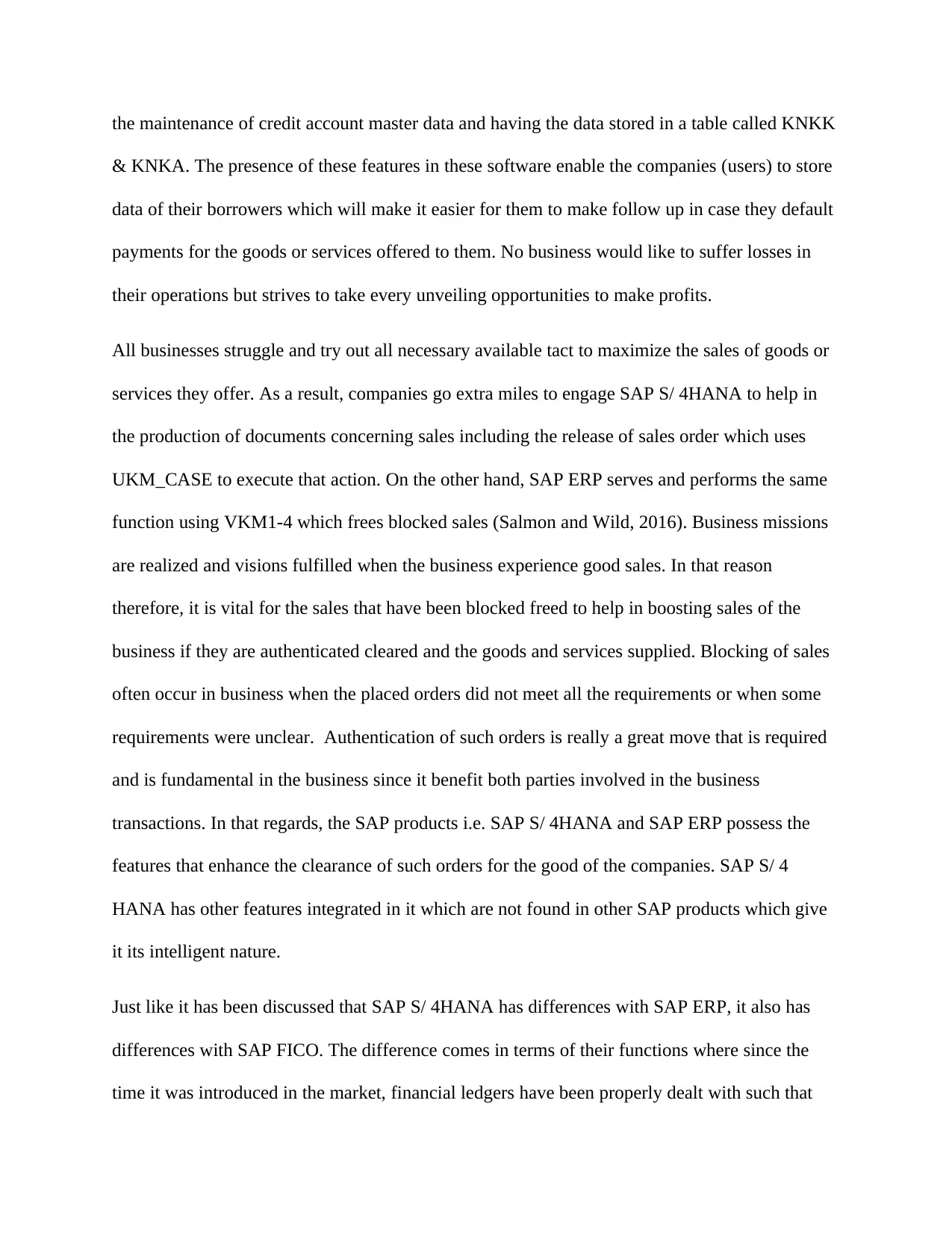
the maintenance of credit account master data and having the data stored in a table called KNKK
& KNKA. The presence of these features in these software enable the companies (users) to store
data of their borrowers which will make it easier for them to make follow up in case they default
payments for the goods or services offered to them. No business would like to suffer losses in
their operations but strives to take every unveiling opportunities to make profits.
All businesses struggle and try out all necessary available tact to maximize the sales of goods or
services they offer. As a result, companies go extra miles to engage SAP S/ 4HANA to help in
the production of documents concerning sales including the release of sales order which uses
UKM_CASE to execute that action. On the other hand, SAP ERP serves and performs the same
function using VKM1-4 which frees blocked sales (Salmon and Wild, 2016). Business missions
are realized and visions fulfilled when the business experience good sales. In that reason
therefore, it is vital for the sales that have been blocked freed to help in boosting sales of the
business if they are authenticated cleared and the goods and services supplied. Blocking of sales
often occur in business when the placed orders did not meet all the requirements or when some
requirements were unclear. Authentication of such orders is really a great move that is required
and is fundamental in the business since it benefit both parties involved in the business
transactions. In that regards, the SAP products i.e. SAP S/ 4HANA and SAP ERP possess the
features that enhance the clearance of such orders for the good of the companies. SAP S/ 4
HANA has other features integrated in it which are not found in other SAP products which give
it its intelligent nature.
Just like it has been discussed that SAP S/ 4HANA has differences with SAP ERP, it also has
differences with SAP FICO. The difference comes in terms of their functions where since the
time it was introduced in the market, financial ledgers have been properly dealt with such that
& KNKA. The presence of these features in these software enable the companies (users) to store
data of their borrowers which will make it easier for them to make follow up in case they default
payments for the goods or services offered to them. No business would like to suffer losses in
their operations but strives to take every unveiling opportunities to make profits.
All businesses struggle and try out all necessary available tact to maximize the sales of goods or
services they offer. As a result, companies go extra miles to engage SAP S/ 4HANA to help in
the production of documents concerning sales including the release of sales order which uses
UKM_CASE to execute that action. On the other hand, SAP ERP serves and performs the same
function using VKM1-4 which frees blocked sales (Salmon and Wild, 2016). Business missions
are realized and visions fulfilled when the business experience good sales. In that reason
therefore, it is vital for the sales that have been blocked freed to help in boosting sales of the
business if they are authenticated cleared and the goods and services supplied. Blocking of sales
often occur in business when the placed orders did not meet all the requirements or when some
requirements were unclear. Authentication of such orders is really a great move that is required
and is fundamental in the business since it benefit both parties involved in the business
transactions. In that regards, the SAP products i.e. SAP S/ 4HANA and SAP ERP possess the
features that enhance the clearance of such orders for the good of the companies. SAP S/ 4
HANA has other features integrated in it which are not found in other SAP products which give
it its intelligent nature.
Just like it has been discussed that SAP S/ 4HANA has differences with SAP ERP, it also has
differences with SAP FICO. The difference comes in terms of their functions where since the
time it was introduced in the market, financial ledgers have been properly dealt with such that
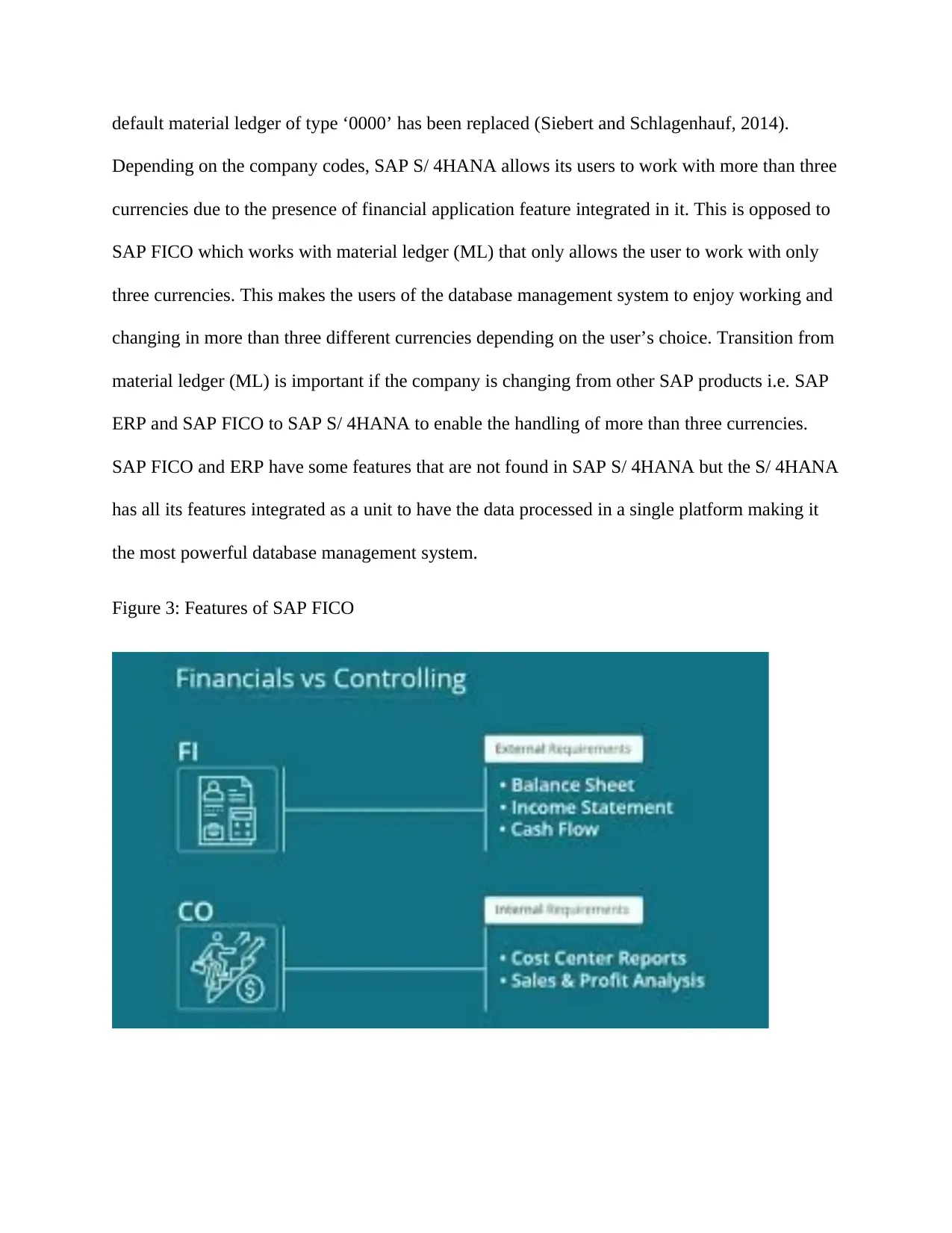
default material ledger of type ‘0000’ has been replaced (Siebert and Schlagenhauf, 2014).
Depending on the company codes, SAP S/ 4HANA allows its users to work with more than three
currencies due to the presence of financial application feature integrated in it. This is opposed to
SAP FICO which works with material ledger (ML) that only allows the user to work with only
three currencies. This makes the users of the database management system to enjoy working and
changing in more than three different currencies depending on the user’s choice. Transition from
material ledger (ML) is important if the company is changing from other SAP products i.e. SAP
ERP and SAP FICO to SAP S/ 4HANA to enable the handling of more than three currencies.
SAP FICO and ERP have some features that are not found in SAP S/ 4HANA but the S/ 4HANA
has all its features integrated as a unit to have the data processed in a single platform making it
the most powerful database management system.
Figure 3: Features of SAP FICO
Depending on the company codes, SAP S/ 4HANA allows its users to work with more than three
currencies due to the presence of financial application feature integrated in it. This is opposed to
SAP FICO which works with material ledger (ML) that only allows the user to work with only
three currencies. This makes the users of the database management system to enjoy working and
changing in more than three different currencies depending on the user’s choice. Transition from
material ledger (ML) is important if the company is changing from other SAP products i.e. SAP
ERP and SAP FICO to SAP S/ 4HANA to enable the handling of more than three currencies.
SAP FICO and ERP have some features that are not found in SAP S/ 4HANA but the S/ 4HANA
has all its features integrated as a unit to have the data processed in a single platform making it
the most powerful database management system.
Figure 3: Features of SAP FICO
⊘ This is a preview!⊘
Do you want full access?
Subscribe today to unlock all pages.

Trusted by 1+ million students worldwide
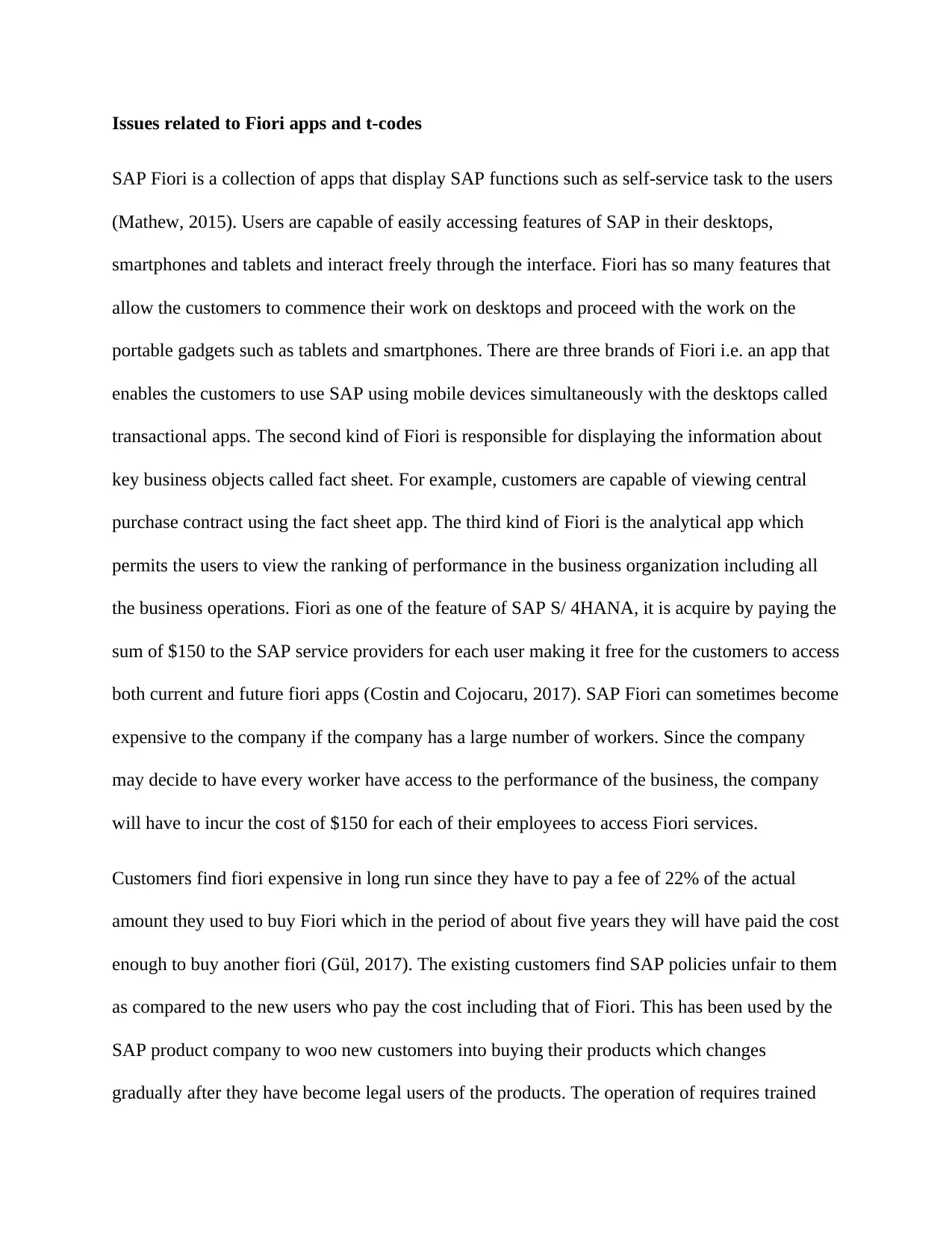
Issues related to Fiori apps and t-codes
SAP Fiori is a collection of apps that display SAP functions such as self-service task to the users
(Mathew, 2015). Users are capable of easily accessing features of SAP in their desktops,
smartphones and tablets and interact freely through the interface. Fiori has so many features that
allow the customers to commence their work on desktops and proceed with the work on the
portable gadgets such as tablets and smartphones. There are three brands of Fiori i.e. an app that
enables the customers to use SAP using mobile devices simultaneously with the desktops called
transactional apps. The second kind of Fiori is responsible for displaying the information about
key business objects called fact sheet. For example, customers are capable of viewing central
purchase contract using the fact sheet app. The third kind of Fiori is the analytical app which
permits the users to view the ranking of performance in the business organization including all
the business operations. Fiori as one of the feature of SAP S/ 4HANA, it is acquire by paying the
sum of $150 to the SAP service providers for each user making it free for the customers to access
both current and future fiori apps (Costin and Cojocaru, 2017). SAP Fiori can sometimes become
expensive to the company if the company has a large number of workers. Since the company
may decide to have every worker have access to the performance of the business, the company
will have to incur the cost of $150 for each of their employees to access Fiori services.
Customers find fiori expensive in long run since they have to pay a fee of 22% of the actual
amount they used to buy Fiori which in the period of about five years they will have paid the cost
enough to buy another fiori (Gül, 2017). The existing customers find SAP policies unfair to them
as compared to the new users who pay the cost including that of Fiori. This has been used by the
SAP product company to woo new customers into buying their products which changes
gradually after they have become legal users of the products. The operation of requires trained
SAP Fiori is a collection of apps that display SAP functions such as self-service task to the users
(Mathew, 2015). Users are capable of easily accessing features of SAP in their desktops,
smartphones and tablets and interact freely through the interface. Fiori has so many features that
allow the customers to commence their work on desktops and proceed with the work on the
portable gadgets such as tablets and smartphones. There are three brands of Fiori i.e. an app that
enables the customers to use SAP using mobile devices simultaneously with the desktops called
transactional apps. The second kind of Fiori is responsible for displaying the information about
key business objects called fact sheet. For example, customers are capable of viewing central
purchase contract using the fact sheet app. The third kind of Fiori is the analytical app which
permits the users to view the ranking of performance in the business organization including all
the business operations. Fiori as one of the feature of SAP S/ 4HANA, it is acquire by paying the
sum of $150 to the SAP service providers for each user making it free for the customers to access
both current and future fiori apps (Costin and Cojocaru, 2017). SAP Fiori can sometimes become
expensive to the company if the company has a large number of workers. Since the company
may decide to have every worker have access to the performance of the business, the company
will have to incur the cost of $150 for each of their employees to access Fiori services.
Customers find fiori expensive in long run since they have to pay a fee of 22% of the actual
amount they used to buy Fiori which in the period of about five years they will have paid the cost
enough to buy another fiori (Gül, 2017). The existing customers find SAP policies unfair to them
as compared to the new users who pay the cost including that of Fiori. This has been used by the
SAP product company to woo new customers into buying their products which changes
gradually after they have become legal users of the products. The operation of requires trained
Paraphrase This Document
Need a fresh take? Get an instant paraphrase of this document with our AI Paraphraser
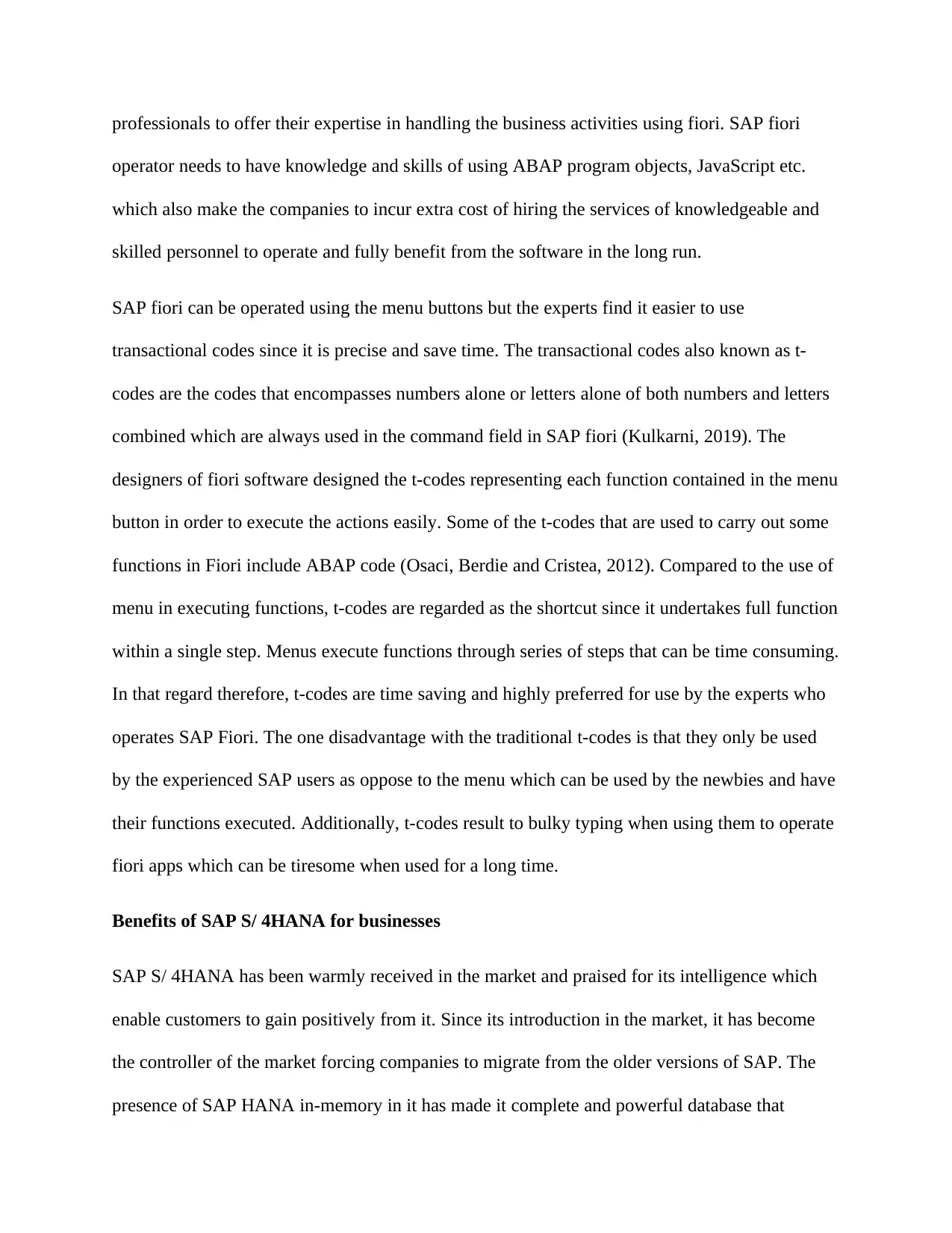
professionals to offer their expertise in handling the business activities using fiori. SAP fiori
operator needs to have knowledge and skills of using ABAP program objects, JavaScript etc.
which also make the companies to incur extra cost of hiring the services of knowledgeable and
skilled personnel to operate and fully benefit from the software in the long run.
SAP fiori can be operated using the menu buttons but the experts find it easier to use
transactional codes since it is precise and save time. The transactional codes also known as t-
codes are the codes that encompasses numbers alone or letters alone of both numbers and letters
combined which are always used in the command field in SAP fiori (Kulkarni, 2019). The
designers of fiori software designed the t-codes representing each function contained in the menu
button in order to execute the actions easily. Some of the t-codes that are used to carry out some
functions in Fiori include ABAP code (Osaci, Berdie and Cristea, 2012). Compared to the use of
menu in executing functions, t-codes are regarded as the shortcut since it undertakes full function
within a single step. Menus execute functions through series of steps that can be time consuming.
In that regard therefore, t-codes are time saving and highly preferred for use by the experts who
operates SAP Fiori. The one disadvantage with the traditional t-codes is that they only be used
by the experienced SAP users as oppose to the menu which can be used by the newbies and have
their functions executed. Additionally, t-codes result to bulky typing when using them to operate
fiori apps which can be tiresome when used for a long time.
Benefits of SAP S/ 4HANA for businesses
SAP S/ 4HANA has been warmly received in the market and praised for its intelligence which
enable customers to gain positively from it. Since its introduction in the market, it has become
the controller of the market forcing companies to migrate from the older versions of SAP. The
presence of SAP HANA in-memory in it has made it complete and powerful database that
operator needs to have knowledge and skills of using ABAP program objects, JavaScript etc.
which also make the companies to incur extra cost of hiring the services of knowledgeable and
skilled personnel to operate and fully benefit from the software in the long run.
SAP fiori can be operated using the menu buttons but the experts find it easier to use
transactional codes since it is precise and save time. The transactional codes also known as t-
codes are the codes that encompasses numbers alone or letters alone of both numbers and letters
combined which are always used in the command field in SAP fiori (Kulkarni, 2019). The
designers of fiori software designed the t-codes representing each function contained in the menu
button in order to execute the actions easily. Some of the t-codes that are used to carry out some
functions in Fiori include ABAP code (Osaci, Berdie and Cristea, 2012). Compared to the use of
menu in executing functions, t-codes are regarded as the shortcut since it undertakes full function
within a single step. Menus execute functions through series of steps that can be time consuming.
In that regard therefore, t-codes are time saving and highly preferred for use by the experts who
operates SAP Fiori. The one disadvantage with the traditional t-codes is that they only be used
by the experienced SAP users as oppose to the menu which can be used by the newbies and have
their functions executed. Additionally, t-codes result to bulky typing when using them to operate
fiori apps which can be tiresome when used for a long time.
Benefits of SAP S/ 4HANA for businesses
SAP S/ 4HANA has been warmly received in the market and praised for its intelligence which
enable customers to gain positively from it. Since its introduction in the market, it has become
the controller of the market forcing companies to migrate from the older versions of SAP. The
presence of SAP HANA in-memory in it has made it complete and powerful database that
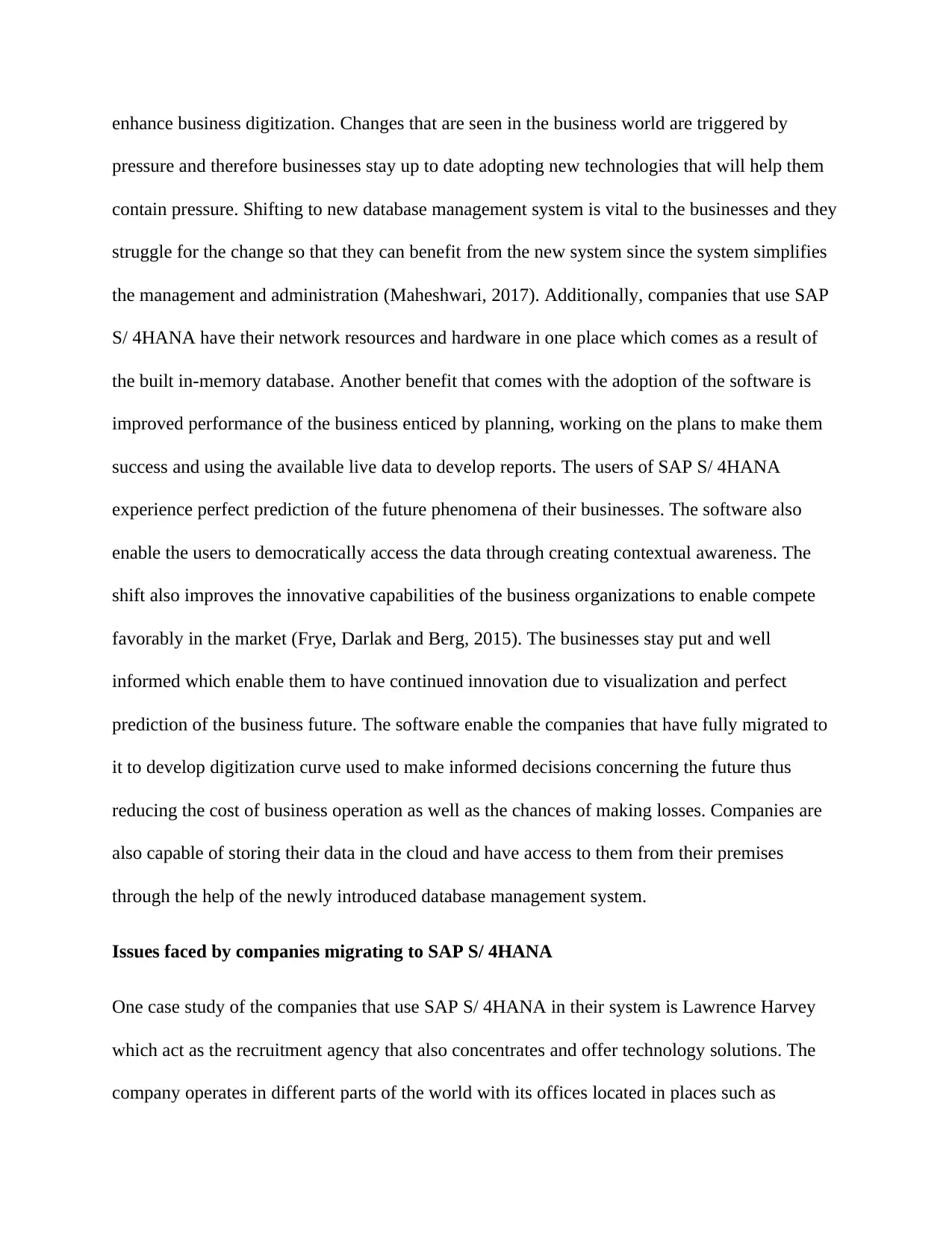
enhance business digitization. Changes that are seen in the business world are triggered by
pressure and therefore businesses stay up to date adopting new technologies that will help them
contain pressure. Shifting to new database management system is vital to the businesses and they
struggle for the change so that they can benefit from the new system since the system simplifies
the management and administration (Maheshwari, 2017). Additionally, companies that use SAP
S/ 4HANA have their network resources and hardware in one place which comes as a result of
the built in-memory database. Another benefit that comes with the adoption of the software is
improved performance of the business enticed by planning, working on the plans to make them
success and using the available live data to develop reports. The users of SAP S/ 4HANA
experience perfect prediction of the future phenomena of their businesses. The software also
enable the users to democratically access the data through creating contextual awareness. The
shift also improves the innovative capabilities of the business organizations to enable compete
favorably in the market (Frye, Darlak and Berg, 2015). The businesses stay put and well
informed which enable them to have continued innovation due to visualization and perfect
prediction of the business future. The software enable the companies that have fully migrated to
it to develop digitization curve used to make informed decisions concerning the future thus
reducing the cost of business operation as well as the chances of making losses. Companies are
also capable of storing their data in the cloud and have access to them from their premises
through the help of the newly introduced database management system.
Issues faced by companies migrating to SAP S/ 4HANA
One case study of the companies that use SAP S/ 4HANA in their system is Lawrence Harvey
which act as the recruitment agency that also concentrates and offer technology solutions. The
company operates in different parts of the world with its offices located in places such as
pressure and therefore businesses stay up to date adopting new technologies that will help them
contain pressure. Shifting to new database management system is vital to the businesses and they
struggle for the change so that they can benefit from the new system since the system simplifies
the management and administration (Maheshwari, 2017). Additionally, companies that use SAP
S/ 4HANA have their network resources and hardware in one place which comes as a result of
the built in-memory database. Another benefit that comes with the adoption of the software is
improved performance of the business enticed by planning, working on the plans to make them
success and using the available live data to develop reports. The users of SAP S/ 4HANA
experience perfect prediction of the future phenomena of their businesses. The software also
enable the users to democratically access the data through creating contextual awareness. The
shift also improves the innovative capabilities of the business organizations to enable compete
favorably in the market (Frye, Darlak and Berg, 2015). The businesses stay put and well
informed which enable them to have continued innovation due to visualization and perfect
prediction of the business future. The software enable the companies that have fully migrated to
it to develop digitization curve used to make informed decisions concerning the future thus
reducing the cost of business operation as well as the chances of making losses. Companies are
also capable of storing their data in the cloud and have access to them from their premises
through the help of the newly introduced database management system.
Issues faced by companies migrating to SAP S/ 4HANA
One case study of the companies that use SAP S/ 4HANA in their system is Lawrence Harvey
which act as the recruitment agency that also concentrates and offer technology solutions. The
company operates in different parts of the world with its offices located in places such as
⊘ This is a preview!⊘
Do you want full access?
Subscribe today to unlock all pages.

Trusted by 1+ million students worldwide
1 out of 18
Related Documents
Your All-in-One AI-Powered Toolkit for Academic Success.
+13062052269
info@desklib.com
Available 24*7 on WhatsApp / Email
![[object Object]](/_next/static/media/star-bottom.7253800d.svg)
Unlock your academic potential
Copyright © 2020–2025 A2Z Services. All Rights Reserved. Developed and managed by ZUCOL.





